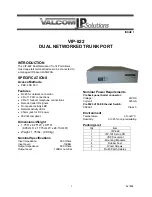
Virtual Link Trunking (VLT)
Virtual link trunking (VLT) allows physical links between two chassis to appear as a single virtual link to the
network core. VLT eliminates the requirement for Spanning Tree protocols by allowing link aggregation group
(LAG) terminations on two separate distribution or core switches, and by supporting a loop-free topology.
VLT provides Layer 2 multipathing, creating redundancy through increased bandwidth and enabling multiple
parallel paths between nodes and load-balancing traffic where alternative paths exist.
NOTE:
When you launch the VLT link, the VLT peer-ship is not established if any of the following is
TRUE
:
• The VLT System-MAC configured on both the VLT peers do not match.
• The VLT Unit-Id configured on both the VLT peers are identical.
• The VLT System-MAC or Unit-Id is configured only on one of the VLT peers.
• The VLT domain ID is not the same on both peers.
If the VLT peer-ship is already established, changing the System-MAC or Unit-Id does not cause VLT
peer-ship to go down.
Also, if the VLT peer-ship is already established and the VLT Unit-Id or System-MAC are configured on
both peers, then changing the CLI configurations on the VLT Unit-Id or System-MAC is rejected.
When the VLT peer-ship is already established, you can remove the VLT Unit-Id or System-MAC
configuration from either or both peers. However, removing configuration settings can cause the VLT
ports to go down.
Topics:
•
•
•
•
lacp ungroup member-independent
•
multicast peer-routing timeout
•
•
•
•
•
•
•
•
•
•
62
Virtual Link Trunking (VLT)
2204
Summary of Contents for C9000 series
Page 1: ...Dell Networking Command Line Reference Guide for the C9000 Series Version 9 10 0 0 ...
Page 394: ...deny 14551 666 Dell Access Control Lists ACL 394 ...
Page 877: ...algorithm FIPS Cryptography 877 ...
Page 1297: ...Total 5 0 Total 5 active route s using 952 bytes IPv6 Basics 1297 ...
















































